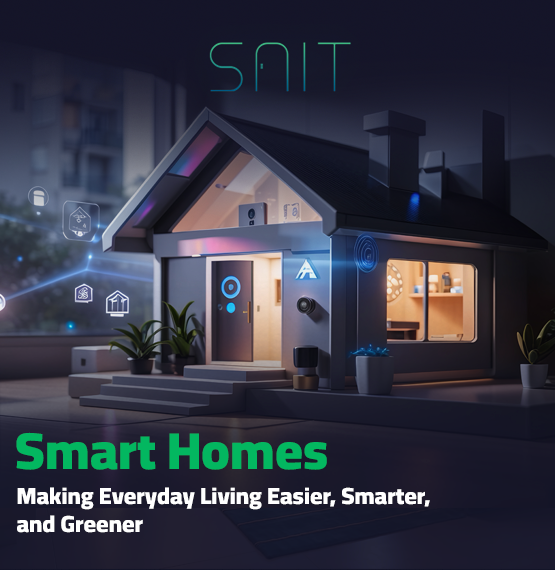AI has taken a huge part in everyday life, reshaping every industry and everyone’s daily life. One of the most exciting areas where innovation has made a real difference is in our homes. Today, we’re seeing the rise of AI smart homes, where your home can adapt to you and manage your tasks without asking other than that it has a great impact on the environment, A technology that is greener and eco-friendly this blog we’re going to get to know how AI can reshape the smart home
A smart home not only makes your life easier, it adds a new dimension of luxury by letting you control every detail with the push of a button or even a simple voice command. Best of all, this technology also serves the environment by minimizing waste and using energy efficiently, combining personal comfort with environmental responsibility.
Smart Home vs. Home Automation: What’s the Difference?
It’s easy to confuse the term “smart home” with “home automation,” but they’re not the same thing.
- Home automation typically refers to systems that use specialized wiring and protocols to control devices within a home.
- Smart homes, on the other hand, rely on connected devices that communicate through the internet. Instead of needing complex installations, smart devices connect to Wi-Fi and can often be managed through one or more apps.
In other words, home automation is more like a static, closed system, while smart homes are dynamic systems that are scalable and customizable according to the needs of each individual or household.
Why a Smart Home Is More Practical
The biggest advantage of
smart homes
It’s the practical side. Instead of complex electrical extensions, any ordinary home can be turned into a smart home with simple steps.
Imagine sitting in your living room and controlling the lights, curtains, and temperature from your phone or through voice commands. It’s not just about convenience, it’s also about energy efficiency, as you can monitor your home appliances in real-time and adjust their usage to suit your lifestyle.
its practicality. With smart control, you can manage multiple aspects of your home without complicated installations or rewiring. For example: Want to dim your bedroom lights, adjust your thermostat, or close the blinds—all without leaving the couch? A smart home makes that possible.
The Magic of Smart Control
What makes a smart home truly “smart” is the ability to unify devices into a single ecosystem. Instead of using one app for your lights, another for your security, and a third for your thermostat, smart control platforms let you bring everything together.
This integration opens the door to advanced automations. For example:
- Your lights automatically turn off when you leave the house.
- The thermostat adjusts to your preferred temperature before you get home.
- Receive instant alerts when motion or intrusion is detected.
- Security cameras send alerts directly to your phone if motion is detected.
Even better, many Smart homes systems work with voice assistants, meaning you can control your entire home hands-free. Just say the word, and your smart home responds.
How Smart Homes Support Sustainability
The benefits of
Smart home
when it comes to comfort and control, but also when it comes to the environment. Energy in traditional homes is often consumed inefficiently, leading to increased carbon emissions.
Smart homes put sustainability at the center of their work by:
- energy efficiency: Appliances automatically turn off when not in use or run during times of low electricity cost.
- Real-time monitoring: Systems that show you the exact consumption of each device, so you can see where the waste is coming from.
- Smart lighting: Works based on motion or time of day, so there’s no chance of forgetting the lights are on.
- Home Appliance Management: Schedule your washing machine or dishwasher to run at night to reduce the strain on the electrical grid.
These practices make the smart home not only a comfort option, but an eco-friendly lifestyle that minimizes both financial costs and emissions.
The Future of Smart Homes
The future holds even greater possibilities as artificial intelligence (AI) is integrated deeper into the smart home. No longer limited to responding to your commands, the technology is able to learn from your habits and act proactively.
For example:
- The system learns your sleeping and waking times to automatically adjust your lighting and curtains.
- It monitors your energy consumption patterns and suggests solutions to minimize waste.
- Improves security by detecting abnormal behavior and sending immediate alerts.
We are heading towards a new phase where smart homes become more like a partner in your daily life, understanding you and anticipating your needs before you ask.
Conclusion
A smart home is no longer a luxury, but a practical way to simplify your life and improve your lifestyle. It combines comfort, efficiency, safety, and environmental sustainability. Choosing a smart home is an investment in the future, as you get a home that interacts with you, saves you time and energy, and preserves the environment at the same time. In a world where everyone is looking for smarter and more sustainable solutions, turning your home into a smart home is undoubtedly one of the smartest decisions you can make today.





